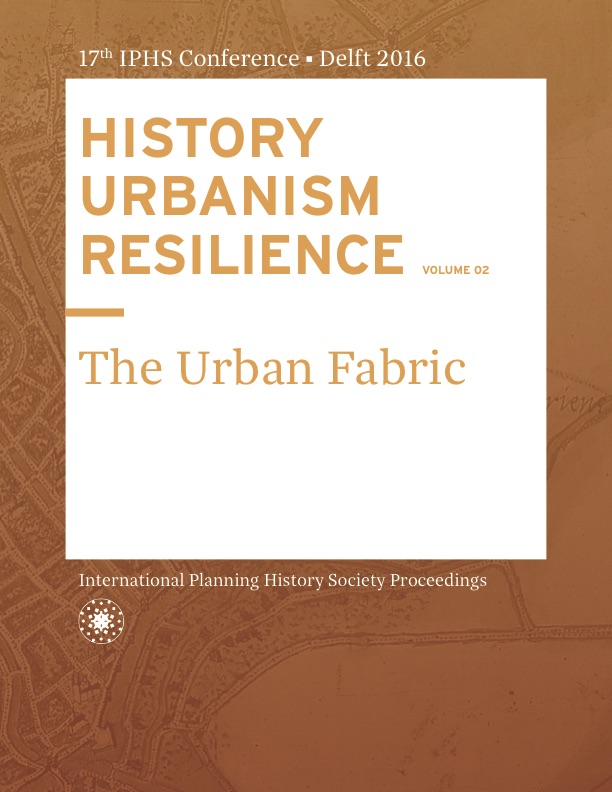Gorakhpur: A Case Study of Resiliency
DOI:
https://doi.org/10.7480/iphs.2016.2.1244Abstract
India with its immense geographic diversity faces multidimensional risks to climate change. Increased flooding, heavy storms and extreme weather events are affecting people's everyday life significantly. According to 'India Today' (September, 2015), the country has a strong history of getting affected by floods starting from 'Bihar floods' in 1987, 'Maharastra floods' in 2005, 'Assam floods' in 2012, 'Uttarakhand floods' in 2013, 'Jammu & Kashmir flash floods' in 2014 & recently 'Chennai flood' in 2015. Statistics related to its devastating effects show how weak infrastructure and services magnify the impacts of extreme events for modern cities.Henceforth, Government of India, while envisioning '100 New Smart Cities' or 'Rejuvenation of 500 old cities' (AMRUT, 2015), does resilience get priority? This research paper will try to investigate the nature of resiliency we should envisage through the case of Gorakhpur (a city located in Uttar Pradesh), because of country's rapid physical as well as climatic transformation, in order to assure safety & sustenance first for its people.
The Asian Cities Climate Change Resilience Network (ACCCRN), supported by the Rockefeller Foundation was launched in 2009 to create climate resilience strategies and action models in 10 cities across four countries in Asia. Gorakhpur was one of the three pilot cities in India to have developed their resilience strategies under the ACCCRN network. Multiple stakeholders joined hands with the city governments to develop resiliency strategies and identified pilot adoption projects for implementation.
“We say ‘live with the flood, our lives were in tune with the floods,” having said that Shiraz Wajih, the Director of GEAG further explains the transformed context of Gorakhpur. “But now the floods come very fast. There are flash floods, landslides and more water logging. So in spite of best preparedness, no one is ready for such uncertainties.” The emerging context of pre-disaster, disaster and post-disaster periods has brought Gorakhpur authorities, civil society experts and farming communities together to work on climate change issues at the heart of disaster preparation plans for last few years.
The impact of the implementation of simple techniques to protect lives and property of the individual tenant farmer when extreme floods and storms arrive is to be documented and described. Necessary actions taken in a ‘response-centric’ manner include running community seed banks with climate-resilient seeds and sharing knowledge about diverse, traditional crop varieties, incorporating locally developed solutions to protect housing from intense storms, to covering crop stores when rain is on the way, and making simple flotation devices to protect non-swimmers.(Rooting Resilience in ODDS, 2011)
The research enquiry will also acknowledge its historical reference by showcasing country's successful example of 'Flood Resiliency'. The sustenance of 3000 year old city, Varanasi on the western bank of Ganges, was assured by putting majestic ghats along with high retaining wall across the span of 'erosion edge'. Contextual reference of such traditional physical planning principles along with a critical analysis on local government & community empowerment will initiate discussion on how contemporary inclusive resilient planning strategies can be framed for modern India.
References
Anil K. Gupta et al., Disaster & Development (NIDM: 2013)
Divya Sharma et al., Urban Climate Resilience: A review of the methodologies adopted under the ACCCRN initiative in Indian Cities (IIED: 2013).
Gorakhpur Environmental Action Group(GEAG), Rooting Resilience in Odds (2013).
Rana P.B Singh, Urban Planning of the Heritage City of Varanasi (India) and its role in Regional Development.
Shiraj A. Wajih et al., Towards a Resilient Gorakhpur (GEAG, ISET & Rockfeller Foundation, 2013).
Stephen Tyler et al., Developing Indicators of Urban Climate Resilience (ISET: 2014).
Downloads
Published
2016-06-29
How to Cite
Chatterjee, D., Frasier, S., & Muku, N. (2016). Gorakhpur: A Case Study of Resiliency. International Planning History Society Proceedings, 17(2). https://doi.org/10.7480/iphs.2016.2.1244
Issue
Section
Conference paper

